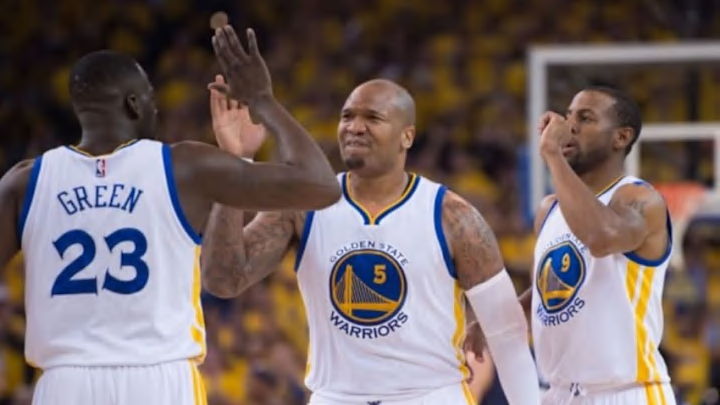
Draymond Green is a far superior player to Marreese Speights on just about every imaginable front. From bulk production to eyetest-based assessments of defense to estimates of overall court impact Green is just better. With the exception of one notable basketball skill[1. Or two, if you want to count Speights’ ability to slide under airborne players and draw questionable offensive foul calls as a legit skill. Team #BanTheCharge does not support this.]: midrange jump shooting.
On shots from outside the paint, but inside the three-point arc, Speights hit 43.6% this season. Green? 34.2%. Almost as relevant, Speights took 321 such shots whereas Green only launched 79 despite playing more than twice as many regular season minutes. Normally, this wouldn’t be a big deal. Midrangers are the opposite of the new hotness, and 43.6% shooting isn’t much to write home about. Green’s inability to hit these shots might be a negative, but his unwillingness to take them mitigates and perhaps even totally overcomes this limitation. Until that shot becomes critical.
In Game One of the NBA Finals, Cleveland’s defensive scheme was designed to make Draymond Green beat them with just that shot. Much like in the Eastern Conference Finals the Cavs were picking their poison defensively. In that series, the plan for competing with the quickness of Atlanta’s point guards Jeff Teague and Dennis Schroeder was to simply not compete with it, dropping deep under pick-and-rolls and daring Teague or Schroeder to beat them with jumpers[3. Which they fairly famously could not do.]:

Against Golden State (and more importantly, facing Steph Curry’s unique ability to shoot from deep off the dribble), Cleveland flipped the script, showing Curry a soft trap and leaving Green open at the elbow area:

First, the Cavs force Green to catch the ball inside the three point line (as he is a willing if and just accurate-enough shooter from deep to not want to concede the three):

Then, Cleveland takes away the best of Green’s “pocket skills[4. To steal a term from the great Jim Petersen.]” by not offering him any passing targets:

Though on this particular play, Green ends up drawing a foul on Mozgov, it’s something of a bailout with Green driving headlong into traffic without much of a plan. Cleveland executed this defensive strategy repeatedly, knowing both that Green doesn’t want to take the offered elbow jumper (again, only 79 midrange attempts, and only 44 midrange catch-and-shoot tries.), and that he has not proven to be particularly effective when forced to create his own shot. Using the estimate discussed here, during the regular season Green had an eFG% of only 31.6% on shots taken with greater than 2.5 seconds of time on the ball before shooting. While he’s been better during the postseason (54.4% eFG during the playoffs through Game One), this sort of bucket-getting is not his best attribute.
Swap Speights into Green’s spot and suddenly allowing the screener to receive the ball at the elbow area isn’t such a good plan:

Now the choice is between leaving Speights, who shot 47.6% on wide open mid range shots this season[1. Per SportVU data.] or helping off one of the other dangerous Warriors. Rolling help to him allows even the shot-happy Mo Buckets to become a playmaker.[4. Such as the Warriors very next possession when Speights was able to hit Green on a quick duck in for a layup.]
Of course, Green wouldn’t be much of a player at all if such a simple adjustment could completely nullify his offensive effectiveness. He’s seen similar coverages at time all year and would figure out how to get to spots in which he’s more comfortable sooner or later. Even in this game, Golden State altered their play to address Cleveland’s defensive strategy, first with this gorgeous wrinkle out of a timeout using the fact that Green wasn’t being guarded to make him a highly effective screener, then later in the game by Curry delaying the pass to the role man just enough to allow his partner to catch and finish at the rim in one dribble instead of two or more. Still, against the specific way in which Cleveland was defending, Speights’ one skill advantege made him a more dangerous player than Green, even if just for a time.
This sort of mico skills difference doesn’t often get discussed in analytics-based dissection of players, but can be absolutely vital to understanding what’s going on. In a broader sense, the sum of all these distinct, subatomic situations is the context in which a player or team operates. Asked to do the things at which they excel, almost anyone in the league can look like an effective player. Take them out of their comfort zone and they might become sub-replacement. A perfect example in these Finals is the role which Iman Shumpert fills for Cleveland as compared to the one he had in New York, and it’s no surprise he looks a far better player with the Cavs.
Especially in the playoffs, where individual strengths and weaknesses can get picked apart, these subtle individualities start to come to the fore in a way that should remind us that players are not monoliths. While many a rating system can illustrate a lot about which player has had the largest overall impact, how they have that impact is frequently as important as the overall size and weight of those contributions.
